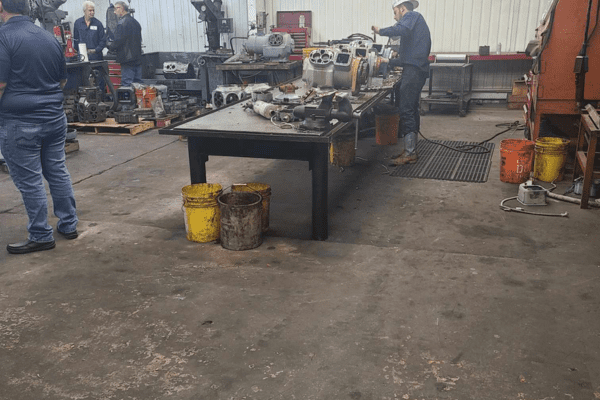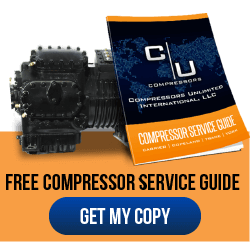In commercial HVAC/R systems, the compressor is the heart of the entire operation. Whether cooling a supermarket, cooling an office so your guests and employees are comfortable, or maintaining climate control in a data center, the compressor is critical in ensuring the system functions efficiently. For HVAC/R technicians, understanding the importance of compressor design is essential to maintaining, troubleshooting, and optimizing these systems.
In this blog, we’ll explore why compressor design is crucial to commercial HVAC/R systems and how a solid understanding of it can enhance performance, improve energy efficiency, and extend the equipment’s lifespan.
The Role of the Compressor in HVAC/R Systems
Before diving into the specifics of design, it’s essential to review compressors’ role in a commercial HVAC/R system. Essentially, the compressor circulates the refrigerant through the system, transforming it from a low-pressure gas to a high-pressure gas. This process is essential in creating the cooling or heating effect that commercial HVAC/R systems rely on.
Without a well-functioning commercial HVAC/R compressor, the refrigerant wouldn’t flow appropriately, and the entire system could malfunction. Compressor reliability and efficiency are non-negotiable in commercial settings where HVAC/R systems run constantly, such as hospitals, office buildings, and industrial facilities.
How Design Affects Commercial HVAC/R Compressor Performance
Compressor design directly impacts the overall performance of the HVAC/R system. Each compressor component, from the valves to the pistons, is engineered to meet specific needs. As a technician, it’s vital to understand how these design features influence performance, energy efficiency, and overall system longevity.
1. Capacity and Load Matching
Commercial HVAC/R compressors are designed with varying capacities to meet different load demands. Proper sizing and capacity matching ensure the compressor doesn’t overwork or underperform. When the compressor is too small for the system, it’s forced to run longer and harder, which leads to inefficiencies, increased wear, and higher energy costs. Conversely, an oversized compressor may cycle on and off too frequently, causing inconsistent cooling or heating and premature wear and tear.
Understanding a building or facility’s specific needs is critical when selecting or recommending compressors. Technicians play a key role in assessing load requirements and ensuring the compressor design aligns with the system’s operational demands.
2. Energy Efficiency and Environmental Impact
As energy costs continue rising, energy-efficient commercial compressor designs have become more critical than ever. Many modern compressors are designed to use less energy while providing the same cooling capacity. This is achieved through advanced technology such as compressor unloaders or adding variable frequency drives (VFDs), which allow compressors to adjust their speed based on the cooling demand. By doing this, they reduce energy consumption during times of low demand and avoid running at total capacity unnecessarily.
Energy-efficient compressor designs are also crucial from an environmental perspective. Compressors with higher efficiency ratings help reduce carbon footprints and meet increasingly stringent regulatory requirements for commercial buildings. Technicians must be familiar with these designs and technologies to advise clients on more sustainable and cost-effective options.
3. Reliability and Durability
Another critical aspect of compressor design is reliability. Commercial HVAC/R systems often run 24/7 in environments where downtime is not an option. Even a brief failure can result in costly damages and disruptions in supermarkets, hospitals, larger offices, data centers, and large-scale manufacturing facilities.
Compressors are built with design features like robust bearings, oil management systems, and pressure control mechanisms to enhance durability and reliability. Technicians must be aware of these design elements to properly maintain compressors, identify potential weak points, and prevent premature failures.
Regular maintenance schedules and attention to key design components can greatly reduce the risk of breakdowns. For example, some compressors come with enhanced filtration systems that reduce contaminants, while others are designed to minimize the risk of oil breakdown. Knowing which design features are in place helps technicians tailor their maintenance practices to keep the system running smoothly.
4. Innovations in HVAC/R Commercial Compressor Design
The HVAC/R industry continues to innovate, and compressor design has not been left behind. Modern compressors are now more compact, quieter, and more efficient than ever before. For example, scroll and screw compressors are increasingly popular in commercial applications due to their efficiency and quieter operation compared to traditional reciprocating compressors.
Technicians must stay current with the latest developments in compressor technology to provide their clients with the best service and solutions. For instance, remanufactured commercial HVAC/R compressors offer viable solutions to older systems by remanufacturing the core of their current compressor. Remanufactured compressors are also a great solution to any budget that needs their cooling operations to stay running without interruption.
Understanding these innovative designs allows HVAC/R technicians to recommend the best solutions for commercial clients, improving overall system efficiency and reducing operating costs.
Compressor Design and System Integration
It’s important to remember that compressor design does not exist in isolation—it’s part of a larger HVAC/R system. The compressor’s design must integrate seamlessly with the system’s other components, including evaporators, condensers, and expansion valves. Poor system integration can lead to inefficiencies, increased wear, and even total system failures.
Technicians must have a solid understanding of how the compressor interacts with other parts of the HVAC/R system. This knowledge is critical when retrofitting systems with new compressors, especially in older buildings where the original design may not accommodate newer technologies. Proper system integration can optimize performance and reduce the likelihood of operational issues down the road.
The Technician’s Role in Maximizing Design Efficiency
As a commercial HVAC/R technician, your understanding of compressor design is critical in ensuring systems run at peak performance. From selecting the right compressor for a new installation to maintaining and troubleshooting existing systems, your knowledge directly impacts system longevity, energy efficiency, and client satisfaction.
Here are some ways technicians can ensure they are maximizing the benefits of compressor design:
- Proper Installation: Ensure the compressor is installed correctly and integrated with the entire system.
- Maintenance: Regular inspections and preventive maintenance help avoid breakdowns and inefficiencies.
- Retrofit Opportunities: Stay informed about new compressor technologies that could improve the performance of older systems.
HVAC/R Commercial Compressors
The design of HVAC/R commercial compressors plays a vital role in system performance, energy efficiency, and longevity. As technology continues to evolve, HVAC/R technicians must stay informed about the latest innovations and best practices to ensure they provide their clients with the highest level of service. A deep understanding of compressor design helps troubleshoot and maintain and advises clients on energy-efficient, reliable, and cost-effective solutions for their commercial HVAC/R needs.












